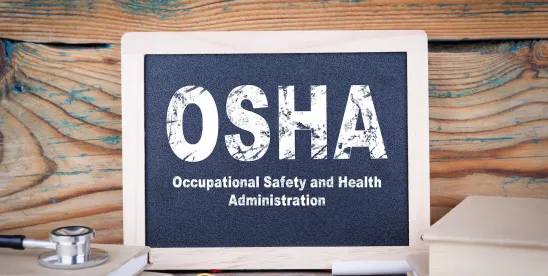On June 25, 2020, the Occupational Safety and Health Administration (OSHA) issued Inspection Procedures for the Respirable Crystalline Silica Standards. The new procedures, 124 pages in length, went into effect immediately.
Beginning of the Inspection
The new procedures set forth the following “playbook” for inspectors:
- Conduct and “collect personal breathing zone samples on the first day of the inspection.” If no silica-generating work is being performed at that time, the procedures state that the inspector should ask the employer for the next available time such work will resume.
- “Request and review” standard documentation, including:
- the employer’s written exposure control plan;
- the employer’s exposure records (such as air monitoring records) or “other data the employer used to assess exposures to determine what exposure levels might be expected before entering the work area”; and
- “laboratory analytical results or chain of custody sample forms.”
For construction employers in particular:
- If the employer is not fully and properly implementing “the specified controls for a Table 1 [Specified Exposure Control Methods When Working With Materials Containing Crystalline Silica] operation or task,” or is performing a task or using equipment not listed in Table 1, the procedures instruct inspectors to assess the employer’s efforts to assess compliance with the permissible exposure limit (PEL).
- If the employer is fully and properly implementing Table 1, the inspector “does not need to collect personal air samples.”
- Under the guidelines, an inspector generally should avoid a regulated area or other areas where anticipated exposures are above the PEL, unless there is an absolute need to do so, the inspector is wearing proper personal protective equipment (PPE), and the inspector has “discuss[ed] the need with [his or her] Area Director (AD) or supervisor prior to entering a regulated area.”
Citation Guidance
The procedures set forth the following for general industry and maritime employers:
- “If samples collected show employee exposure above the PEL of 50 µg/m3, cite 29 C.F.R § 1910.1053(c).”
- “[B]ut [if] the employer has instituted all feasible engineering and work practice controls and employees are adequately protected by an effective respiratory protection program, then there is no PEL violation.”
“For construction employers:
- Where the employer has fully and properly implemented the engineering controls, work practices, and respiratory protection specified on Table 1, then there is no PEL violation.
- Where the employer has not fully and properly implemented the engineering controls, work practices, and respiratory protection specified on Table 1 and sampling shows exposure over the PEL, the [inspector] should cite § 1926.1153(c)(1) and paragraph (d)(1) as grouped violations.” (Emphasis added.)
Compliance Checklists
Near the back of the inspection procedures are compliance checklists, one for the construction industry and one for general industry and maritime. Each checklist contains specific step-by-step checkboxes for all topics covered in the inspection procedures. Employers may want to print copies of these checklists and utilize them to enforce their compliance efforts.
Hydraulic Fracking Inspection Guidelines
The procedures also contain, at Appendix G, a primer on inspections of fracturing or “fracking” operations, giving an overview of the general process. OSHA first asks its inspectors to determine the proppant used (silica sand being the most common). Inspectors must then evaluate the fracking employer’s exposure assessment materials and evaluate the on-site regulated areas. Next, inspectors must review the engineering controls on location, with a focus on the local exhaust ventilation unit, proppant loading and moving equipment, and the efficiency of heating, ventilation, and air conditioning (HVAC) filtration systems in mobile equipment, change trailers, and work trailers. The guidelines also require inspectors to evaluate the employer’s use of administrative controls, such as ensuring employees are not standing around or working close to silica dust sources when they are not engaged in a silica task. OSHA tells inspectors to pay heed to equipment maintenance, which can “greatly reduce sources of [silica] dust emissions”. Finally, inspectors are to review fugitive dust controls and the fracking employer’s written exposure control plan, respiratory protection program, and general housekeeping practices.
Key Takeaways
-
The checklists at Appendix F may offer employers the best measure of compliance assurance. Employers may want to incorporate the checklists into their safety compliance programs and have their internal health, safety, and environmental personnel utilize the checklists and inspection guidelines to simulate OSHA inspections of their own worksites and take any appropriate corrective action.
-
As noted in our previous analysis of OSHA inspection data, inspectors enforcing the silica in construction standard generally took an either/or approach when an employer did not follow Table 1: cite under either 29 C.F.R. 1926.1153(c)(1) or 29 C.F.R. § 1926.1153(d)(2)(i) for not conducting an exposure assessment (which is only required only if the employer did not follow Table 1). Here, OSHA is suggesting the best approach is to cite employers for violations of both sections, not just one.
-
Most inspectors conducting construction inspections, however, do not appear to conduct any sampling; instead, they observe the workplace and determine if the employer is following Table 1. If the employer was not following Table 1, the inspector would recommend a violation for 29 C.F.R. 1926.1153(c)(1). Now OSHA is advising inspectors to also cite employers under 29 C.F.R. § 1926.1153(d)(2), which is a violation for exceeding the PEL. But if the inspector never conducts sampling, OSHA has no evidence that the employer was actually exceeding the PEL at the time of the inspection. The updated procedures suggest inspectors should now always conduct sampling at all construction sites.
-
OSHA clarifies that while general industry and maritime employers can use Table 1 for tasks indistinguishable from those set out in Table 1, it is only meant for uncommon and non-routine situations. “This exception is intended for situations where the tasks will be performed in different environments and conditions, rather than in a stable and predictable environment.”
-
OSHA’s silica standards removed proposed prohibitions against employee rotation, after much criticism from the stakeholder community. But now OSHA is stating that “this practice is discouraged,” and warns employers it may potentially increase the number of employees subject to the medical surveillance requirements.
-
OSHA’s interpretation of “under any foreseeable conditions” appears to render the “objective data” exception to silica compliance moot and effectively reads it out of the standard. Employers in general industry and maritime industries are exempt from the silica standard if they possess “objective data demonstrating that employee exposures to respirable crystalline silica will remain below [the action level] … under any foreseeable conditions.” OSHA then interprets “under any foreseeable conditions” to include “failure of most controls.” But if that never happens in practice, how can it be a “foreseeable condition?” Technology is constantly improving. Engineering controls and their reliability are getting better, not worse.
-
OSHA also suggests that any objective data proffered by employers should “reflect[] ‘worst case’ conditions.” But industry surveys are typically conducted under common and representative What’s a “worst case” scenario? The answer is largely left to the imagination of the inspector, who may envision an unlikely parade of horribles to call into question and reject the employer’s objective data. This would force all employers, large and small, to conduct exhaustive air sampling for each work site, something OSHA insisted the silica standards would not require.





 />i
/>i
